air conditioning BUICK REGAL 1997 Owners Manual
[x] Cancel search | Manufacturer: BUICK, Model Year: 1997, Model line: REGAL, Model: BUICK REGAL 1997Pages: 422, PDF Size: 21.34 MB
Page 158 of 422
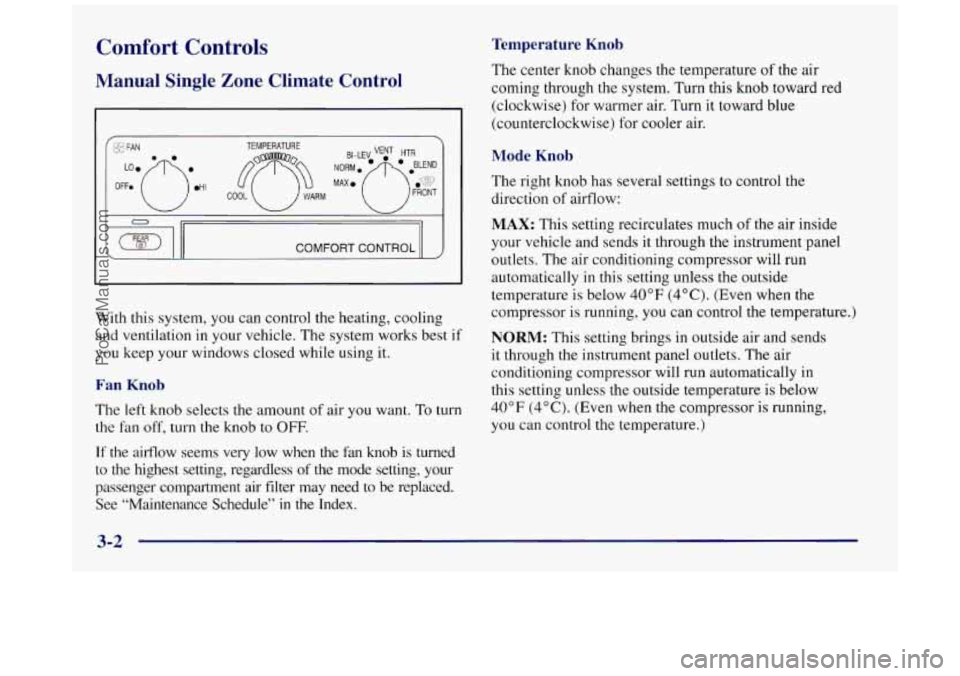
Comfort Controls
Manual Single Zone Climate Control
COMFORT CONTROL II
With this system, you can control the heating, cooling
and ventilation in your vehicle, The system works best if
you keep your windows closed while using it.
Fan Knob
The left knob selects the amount of air you want. To turn
the fan off, turn the knob to
OFF.
If the airflow seems very low when the fan knob is turned
to
the highest setting, regardless of the mode setting, your
passenger compartment air filter may need to be replaced. See “Maintenance Schedule”
in the Index.
Temperature Knob
The center knob changes the temperature of the air
coming through the system. Turn this knob toward red
(clockwise) for warmer air. Turn it toward blue
(counterclockwise) for cooler air.
Mode Knob
The right knob has several settings to control the
direction of airflow:
MAX: This setting recirculates much of the air inside
your vehicle and sends it through the instrument panel
outlets. The air conditioning compressor will run
automatically
in this setting unless the outside
temperature is below
40°F (4°C). (Even when the
compressor is running,
you can control the temperature.)
NORM: This setting brings in outside air and sends
it through the instrument panel outlets. The air
conditioning compressor will run automatically in
this setting unless the outside temperature
is below
40°F (4°C). (Even when the compressor is running,
you can control the temperature.)
3-2
ProCarManuals.com
Page 159 of 422
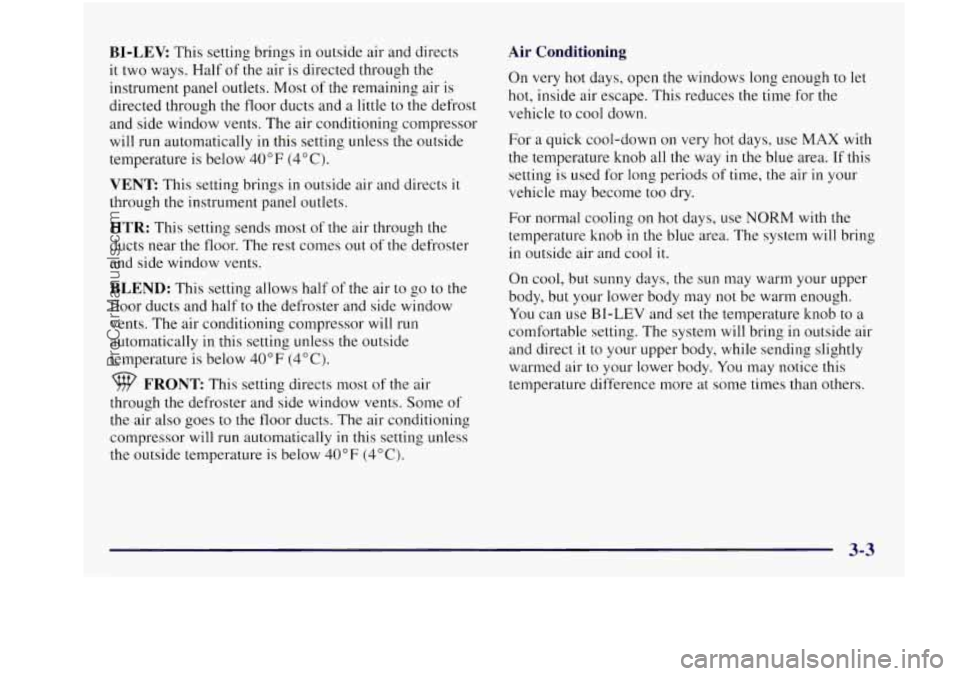
BI-LEV This setting brings in outside air and directs
it two ways. Half of the air is directed through the
instrument panel outlets. Most of the remaining air
is
directed through the floor ducts and a little to the defrost
and side window vents. The air conditioning compressor
will run automatically in this setting unless the outside
temperature is below
40°F (4°C).
VENT This setting brings in outside air and directs it
through the instrument panel outlets.
HTR: This setting sends most of the air through the
ducts near
the floor. The rest comes out of the defroster
and side window vents.
BLEND: This setting allows half of the air to go to the
floor ducts and half to the defroster and side window
vents. The air conditioning compressor will run
automatically in this setting unless the outside
temperature is below
40 OF (4 O C) .
FRONT This setting directs most of the air
through
the defroster and side window vents. Some of
the air also goes to the floor ducts. The air conditioning
compressor will run automatically
in this setting unless
the outside temperature is below
40°F (4°C).
Air Conditioning
On very hot days, open the windows long enough to let
hot, inside air escape. This reduces the time for the
vehicle to cool down.
For a quick cool-down on very hot days, use
MAX with
the temperature knob all the way in the blue area. If this
setting is used for long periods of time, the air
in your
vehicle may become too dry.
For normal cooling on hot days, use NORM with the
temperature knob in the blue area. The system will bring
in outside air and cool it.
On cool, but sunny days, the sun may warm your upper
body, but your lower body may not be warm enough.
You can use
BI-LEV and set the temperature knob to a
comfortable setting. The system will bring in outside air
and direct it
to your upper body, while sending slightly
warmed air to your lower body.
You may notice this
temperature difference more at some times than others.
3-3
ProCarManuals.com
Page 161 of 422
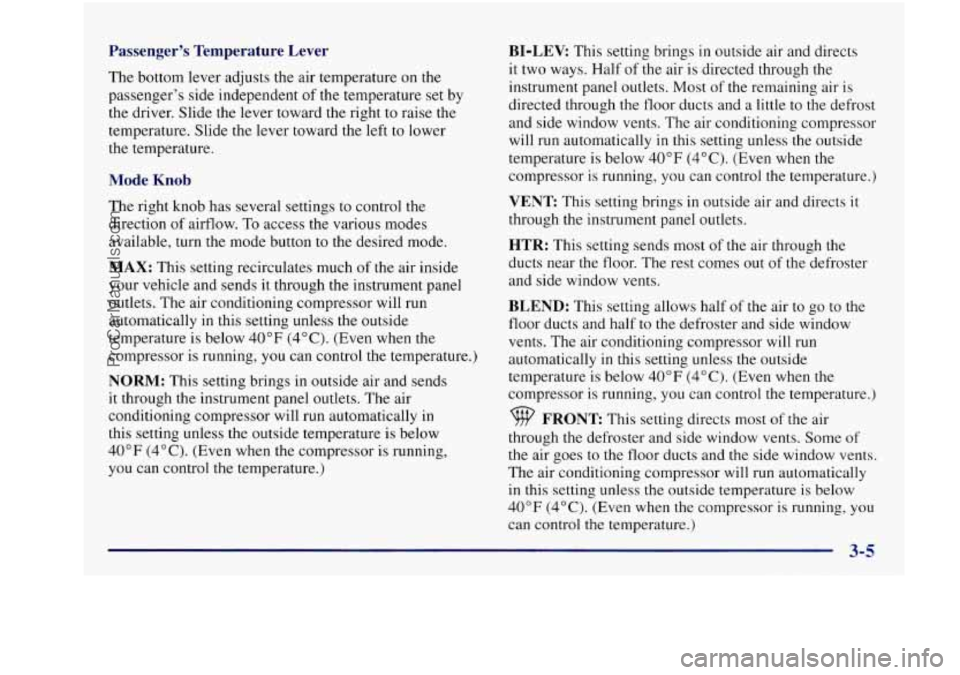
Passenger's Temperature Lever
The bottom lever adjusts the air temperature on the
passenger's side independent of the temperature set by
the driver. Slide the lever toward the right
to raise the
temperature. Slide the lever toward the left to lower
the temperature.
Mode Knob
The right knob has several settings to control the
direction of airflow.
To access the various modes
available, turn the mode button to the desired mode.
MAX: This setting recirculates much of the air inside
your vehicle and sends it through the instrument panel
outlets. The air conditioning compressor will run
automatically
in this setting unless the outside
temperature
is below 40" F (4°C). (Even when the
compressor is running, you can control the temperature.)
NORM: This setting brings in outside air and sends
it through the instrument panel outlets. The air
conditioning compressor will run automatically in
this setting unless the outside temperature is below
40°F (4°C). (Even when the compressor is running,
you can control the temperature.)
BI-LEV: This setting brings in outside air and directs
it two ways. Half of the air is directed through the
instrument panel outlets. Most of the remaining air is
directed through the floor ducts and a little to the defrost
and side window vents. The air conditioning compressor
will run automatically in this setting unless the outside
temperature is below
40°F (4°C). (Even when the
compressor is running, you can control the temperature.)
VENT This setting brings in outside air and directs it
through the instrument panel outlets.
HTR: This setting sends most of the air through the
ducts near the floor. The rest comes out of the defroster
and side window vents.
BLEND: This setting allows half of the air to go to the
floor ducts and half
to the defroster and side window
vents. The air conditioning compressor will run
automatically in this setting unless the outside
temperature is below
40°F (4°C). (Even when the
compressor is running, you can control the temperature.)
9 FRONT This setting directs most of the air
through the defroster and side window vents. Some
of
the air goes to the floor ducts and the side window vents.
The air conditioning compressor will run automatically
in this setting unless the outside temperature is below
40°F (4°C). (Even when the compressor is running, you
can control
the temperature.)
3-5
ProCarManuals.com
Page 162 of 422
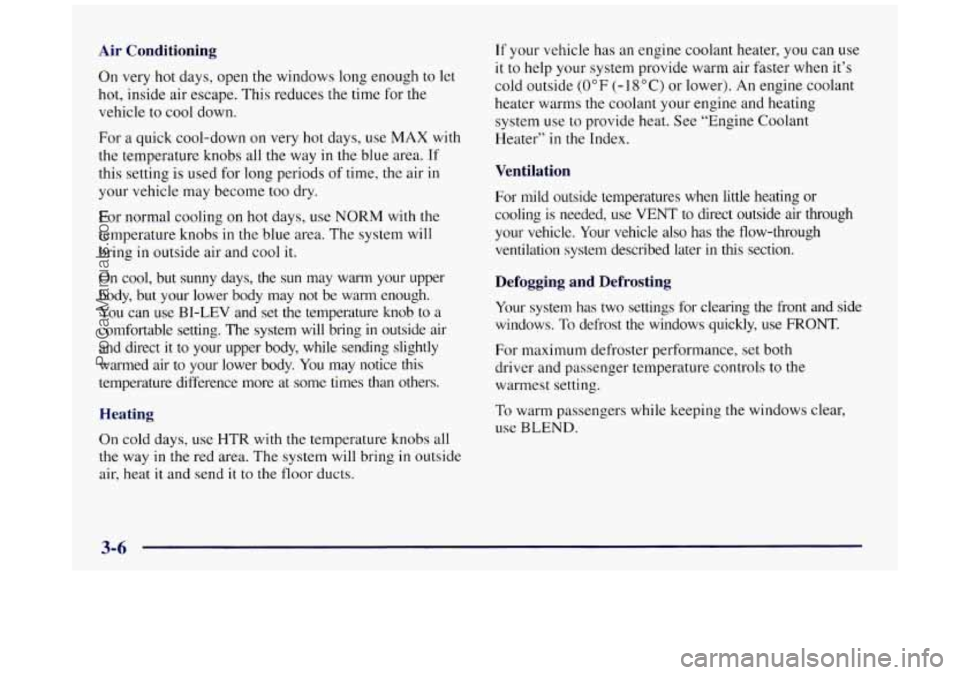
Air Conditioning
On very hot days, open the windows long enough to let
hot, inside air escape. This reduces the time for the
vehicle to cool down.
For a quick cool-down on very hot days, use MAX with
the temperature knobs all the way
in the blue area. If
this setting is used for long periods of time, the air in
your vehicle may become too dry.
For normal cooling on hot days, use
NORM with the
temperature knobs in the blue area. The system will
bring
in outside air and cool it.
On cool, but sunny days, the
sun may warm your upper
body,
but your lower body may not be warm enough.
You can use BI-LEV and set the temperature knob to a
comfortable setting. The system will bring in outside air
and direct it to your upper body, while sending slightly
warmed air to your lower body. You may notice this
temperature difference more at some times than others.
Heating
On cold days, use HTR with the temperature knobs all
the way in the red area. The system will bring
in outside
air, heat it and send it to
the floor ducts.
If your vehicle has an engine coolant heater, you can use
it to help your system provide warm air faster when it’s
cold outside
(0°F (-18°C) or lower). An engine coolant
heater warms the coolant your engine and heating
system use to provide heat. See “Engine Coolant
Heater” in
the Index.
Ventilation
For mild outside temperatures when little heating or
cooling is needed, use VENT to direct outside air through
your vehicle. Your vehicle also has the flow-through
ventilation system described later
in this section.
Defogging and Defrosting
Your system has two settings for clearing the front and side
windows.
To defrost the windows quickly, use FRONT.
For maximum defroster performance, set both
driver and passenger temperature controls to the
warmest setting.
To warm passengers while keeping the windows clear,
use
BLEND.
3-6
ProCarManuals.com
Page 163 of 422
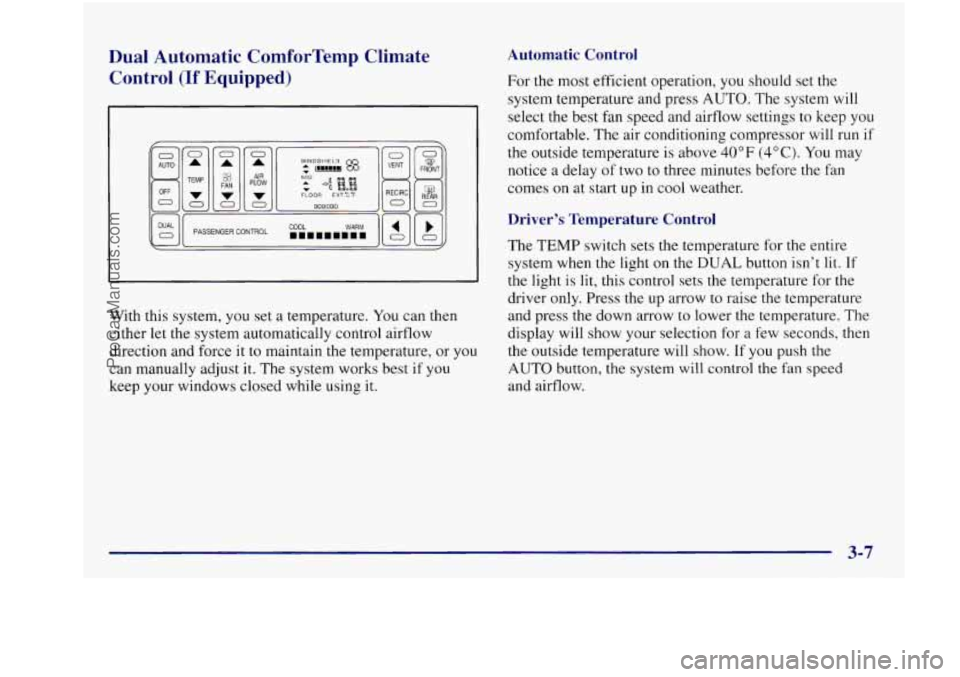
Dual Automatic ComforTemp Climate Control
(If Equipped)
FRONT
With this system, you set a temperature. You can then
either let the system automatically control airflow
direction and force
it to maintain the temperature, or you
can manually adjust it.
The system works best if you
keep your windows closed while using it.
Automatic Control
For
the most efficient operation, you should set the
system temperature and press AUTO. The system will
select the best fan speed and airflow settings to keep you
comfortable. The air conditioning compressor will run if
the outside temperature is above
40°F (4°C). You may
notice a delay of two to three minutes before the fan
comes on at start up in cool weather.
Driver's Temperature Control
The TEMP switch sets the temperature for the entire
system when the light on the DUAL button isn't lit. If
the light
is lit, this control sets the temperature for the
driver only. Press the up arrow to raise the temperature
and press the down arrow to lower the temperature. The
display will show your selection for a few seconds, then
the outside temperature will show. If
you push the
AUTO button, the system will control the fan speed
and airflow.
ProCarManuals.com
Page 165 of 422
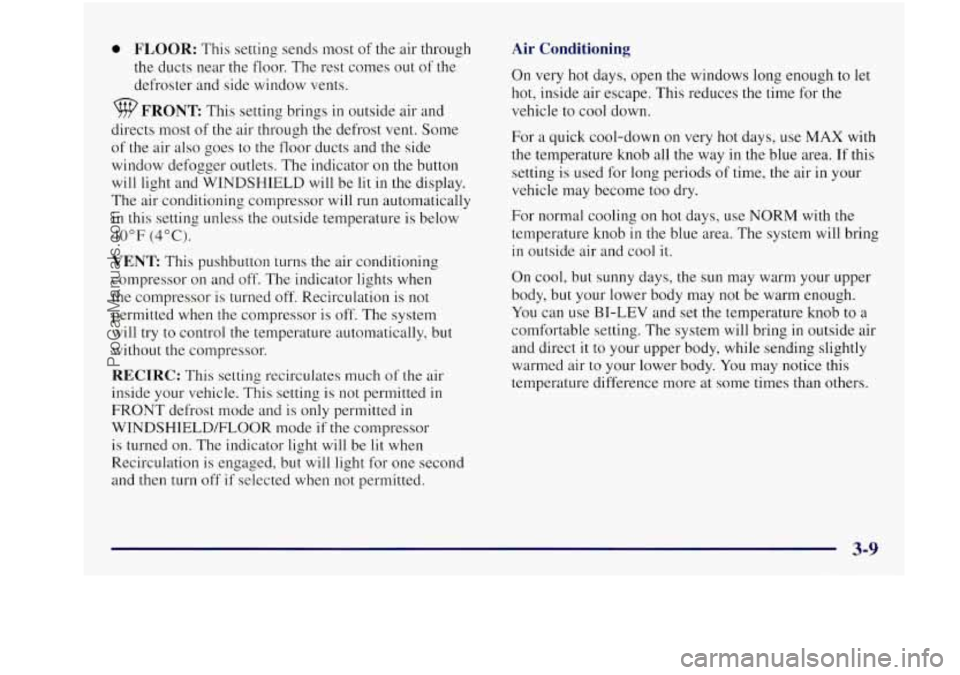
0 FLOOR: This setting sends most of the air through
the ducts near the floor. The rest comes out
of the
defroster and side window vents.
WFRONT This setting brings in outside air and
directs most of the air through the defrost vent. Some
of the air also goes to the floor ducts and the side
window defogger outlets. The indicator on the button
will light and WINDSHIELD will be lit in the display.
The air conditioning compressor will run automatically
in this setting unless the outside temperature is below
40°F (4°C).
VENT: This pushbutton turns the air conditioning
compressor on and off. The indicator lights when
the compressor is turned off. Recirculation is not
permitted when
the compressor is off. The system
will try to control the temperature automatically, but
without the compressor.
RECIRC: This setting recirculates much of the air
inside your ve.hicle. This setting is not permitted
in
FRONT defrost mode and is only permitted in
WINDSHIELD/FLOOR mode if the compressor
is turned on. The indicator light will be lit when
Recirculation is engaged, but will light for one second
and then turn
off if selected when not permitted.
Air Conditioning
On very hot days, open the windows long enough to let
hot, inside air escape. This reduces the time for the
vehicle to cool down.
For
a quick cool-down on very hot days, use MAX with
the temperature knob all
the way in the blue area. If this
setting
is used for long periods of time, the air in your
vehicle may become too dry.
For normal cooling on hot days, use NORM with
the
temperature knob in the blue area. The system will bring
in outside air and cool it.
On cool, but sunny days, the sun may warm your upper
body, but your lower body may not be warm enough.
You can use BI-LEV and set the temperature knob to a
comfortable setting. The system will bring in outside air
and direct it to your upper body, while sending slightly
warmed air to your lower body.
You may notice this
temperature difference more at some times than others.
3-9
ProCarManuals.com
Page 166 of 422
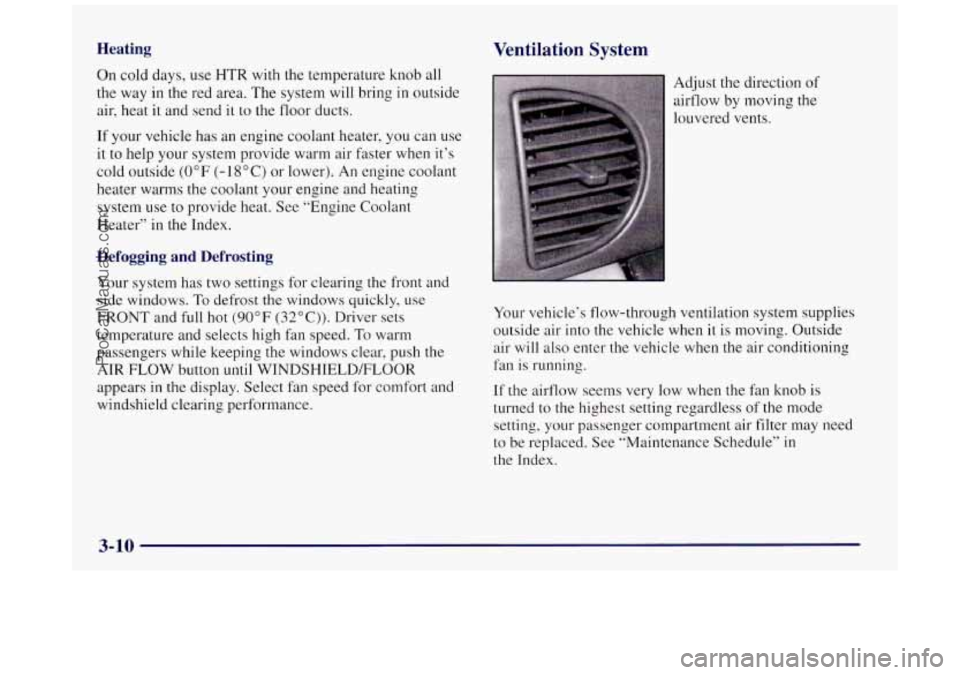
Heating
On cold days, use HTR with the temperature knob all
the way in the red area. The system will bring in outside
air, heat it and send it to the floor ducts.
Ventilation System
If your vehicle has an engine coolant heater, you can use
it to help your system provide warm air faster when it’s
cold outside
(0°F (-18°C) or lower). An engine coolant
heater warms the coolant your engine and heating
system use to provide heat. See “Engine Coolant
Heater” in
the Index.
Defogging and Defrosting
Your system has two settings for clearing the front and
side windows.
To defrost the windows quickly, use
FRONT and full hot
(90°F (32°C)). Driver sets
temperature and selects high fan speed.
To warm
passengers while keeping the windows clear, push the
AIR FLOW button until WINDSHTELDFLOOR
appears
in the display. Select fan speed for comfort and
windshield clearing performance. Adjust the direction
of
airflow by moving the
louvered vents.
Your vehicle’s flow-through ventilation system supplies
outside air into the vehicle when
it is moving. Outside
air will also enter the vehicle when the
air conditioning
fan is running.
If the airflow seems very low when the fan knob is
turned to the highest setting regardless of
the mode
setting, your passenger compartment air filter may need
to be replaced. See “Maintenance Schedule” in
the Index.
3-10
ProCarManuals.com
Page 277 of 422
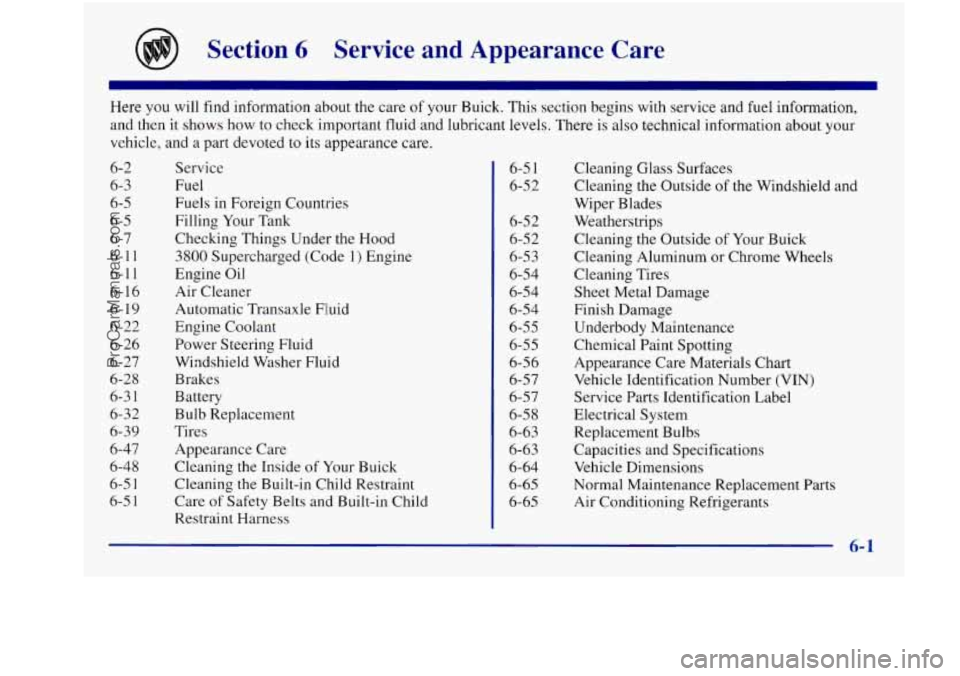
Section 6 Service and Appearance Care
Here you will find information about the care of your Buick. This section begins with service and fuel information,
and then it shows how
to check important fluid and lubricant levels. There is also technical information about your
6-2
6-3
6-5
6-5
6-7
6-11
6-1
1
6-16
6-19
6-22
6-26
6-27
6-28
6-3
1
6-32 6-39
6-47
6-48
6-5
1
6-5 1
vehicle, and a part devoted to its appearance care.
Service
Fuel
Fuels in Foreign Countries
Filling Your Tank
Checking Things Under the Hood
3800 Supercharged (Code 1) Engine
Engine Oil
Air Cleaner
Automatic Transaxle Fluid
Engine Coolant
Power Steering Fluid
Windshield Washer Fluid
Brakes
Battery
Bulb Replacement
Tires
Appearance Care
Cleaning the Inside
of Your Buick
Cleaning the Built-in Child Restraint
Care
of Safety Belts and Built-in Child
Restraint Harness 6-5
1
6-52
6-52
6-52
6-53
6-54 6-54
6-54
6-55
6-55
6-5 6
6-57
6-57
6-58
6-63
6-63
6-64
6-65
6-65 Cleaning Glass Surfaces
Cleaning
the Outside of the Windshield and
Wiper Blades
Weatherstrips Cleaning the Outside of Your Buick
Cleaning Aluminum or Chrome Wheels
Cleaning Tires
Sheet Metal Damage
Finish Damage
Underbody Maintenance
Chemical Paint Spotting
Appearance Care Materials Chart
Vehicle Identification Number
(VIN)
Service Parts Identification Label
Electrical System Replacement Bulbs
Capacities and Specifications
Vehicle Dimensions
Normal Maintenance Replacement Parts
Air Conditioning Refrigerants
6-1
ProCarManuals.com
Page 339 of 422
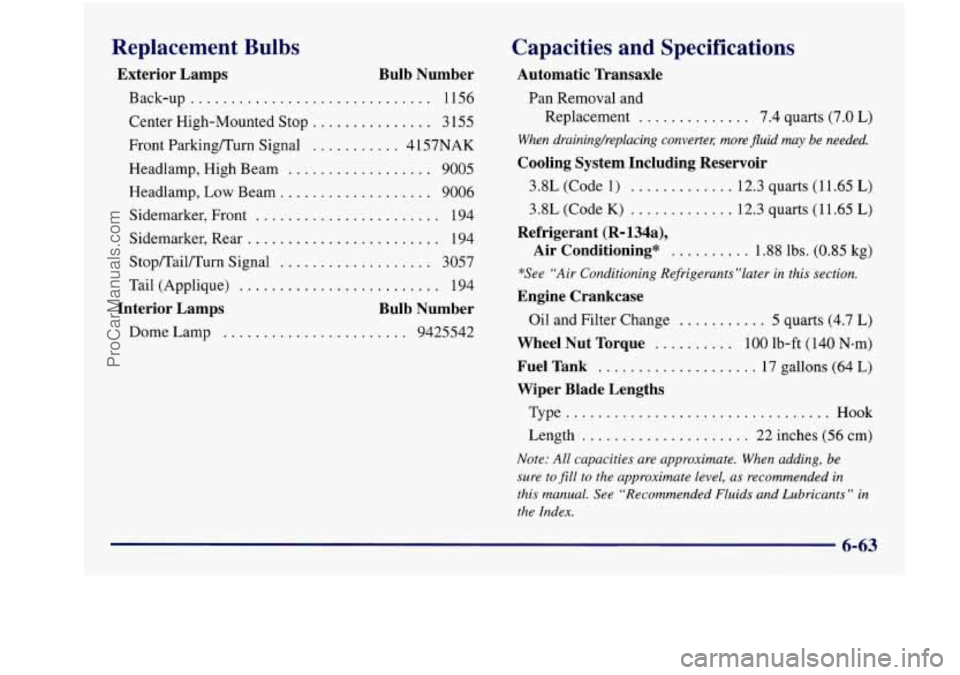
Replacement Bulbs
Exterior Lamps Bulb Number
Back-up .............................. 1156
Center High-Mounted Stop
............... 3 155
Front Parking/Turn Signal
........... 4 157NAK
Headlamp, High Beam
.................. 9005
Headlamp,
Low Beam. .................. 9006
Sidemarker, Front
....................... 194
Sidemarker, Rear
........................ 194
Stop/Tail/Turn Signal
................... 3057
Tail (Applique)
......................... 194
Interior Lamps Bulb Number
Dome Lamp ....................... 9425542
Capacities and Specifications
Automatic nansaxle
Pan Removal and
Replacement
.............. 7.4 quarts (7.0 L)
When drainingheplacing converter; more fluid my be needed.
Cooling System Including Reservoir
3.8L (Code 1) ............. 12.3 quarts (1 1.65 L)
3.8L (Code K) ............. 12.3 quarts (1 1.65 L)
Air Conditioning* .......... 1.88 lbs. (0.85 kg)
Refrigerant (R=134a),
*See “Air Conditioning Refrigerants”1ater in this section.
Engine Crankcase
Oil and Filter Change ........... 5 quarts (4.7 L)
Wheel Nut Torque .......... 100 lb-ft (140 N-m)
Fuel Tank .................... 17 gallons (64 L)
Wiper Blade Lengths
Type ................................. Hook
Length ..................... 22 inches (56 cm)
Note: All capacities are approximate. When adding, be
sure to
fill to the approximate level, as recommended in
this manual. See “Recommended Fluids and Lubricants
” in
the Index.
6-63
ProCarManuals.com
Page 341 of 422
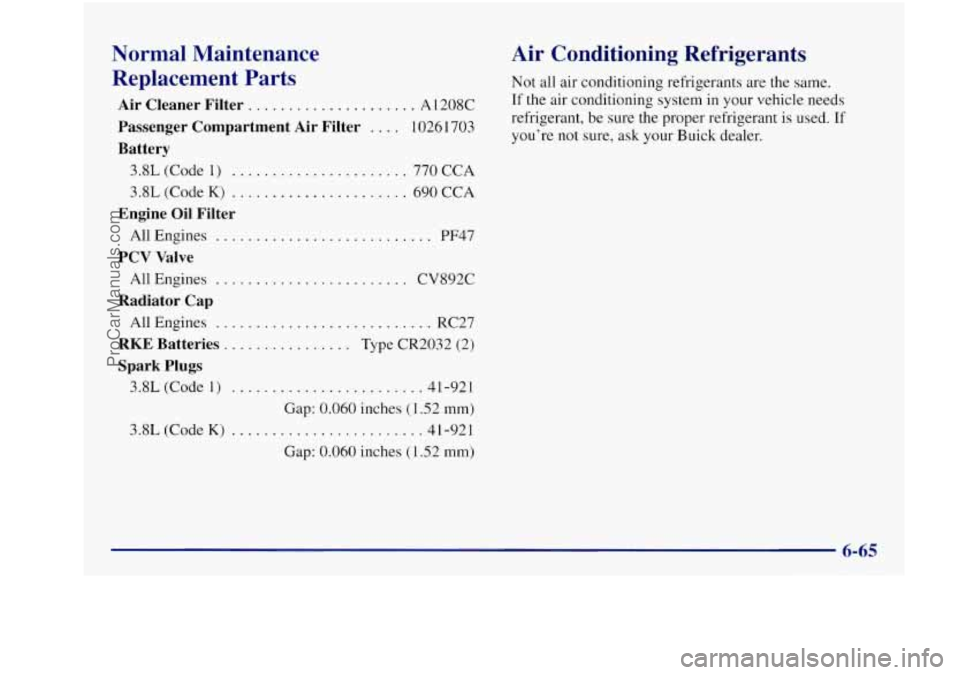
Normal Maintenance
Replacement Parts
Passenger Compartment Air Filter .... 10261 703
Air Cleaner Filter ..................... A 1208C
Battery
3.8L (Code 1) ...................... 770 CCA
3.8L (Code K) ...................... 690 CCA
Engine Oil Filter
All Engines ........................... PF47
PCV Valve
All Engines ........................ CV892C
Radiator Cap
All Engines ........................... RC27
RKE Batteries ................ Type CR2032 (2)
Spark Plugs
3.8L (Code 1) ........................ 41-921
Gap:
0.060 inches (1.52 mm)
3.8L (Code
K) ....................... .41-921
Gap: 0.060 inches (1.52
mm)
Air Conditioning Refrigerants
Not all air conditioning refrigerants are the same.
If the air conditioning system in your vehicle needs
refrigerant, be sure the proper refrigerant is used. If
you’re not sure, ask your Buick dealer.
ProCarManuals.com